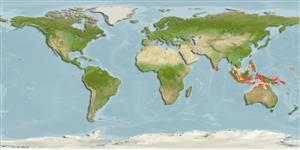>
Eupercaria/misc (Various families in series Eupercaria) >
Malacanthidae (Tilefishes)
Etymology: Hoplolatilus: Greek, hoplon = weapon + Latin, latus = wide (Ref. 45335).
Environment: milieu / climate zone / depth range / distribution range
Ecología
marino asociado a arrecife; rango de profundidad 30 - 85 m (Ref. 90102), usually 35 - 70 m (Ref. 27115). Tropical; 22°C - 28°C (Ref. 27115)
Indo West Pacific: Philippines south to Indonesia east to Solomon Islands.
Tamaño / Peso / Age
Maturity: Lm ? range ? - ? cm
Max length : 13.0 cm TL macho / no sexado; (Ref. 9710)
Espinas dorsales (total) : 9; Radios blandos dorsales (total) : 18 - 19; Espinas anales: 1; Radios blandos anales: 15 - 16; Vértebra: 24. Preopercular serrae 37-48 (Ref. 9933). Greatest depth of body 5.2-5.5 in SL; overall magenta body color; broad, red upper and lower margins on tail (Ref. 90102).
Occurs on sand and rubble patches of steep seaward slopes. Usually in pairs (Ref. 9710).
Life cycle and mating behavior
Madurez | Reproducción | Puesta | Huevos | Fecundidad | Larva
Displays obligate monogamy where a one-to-one pair is established irrespective of resource abundance (Ref. 52884).
Burgess, W.E., 1978. Two new species of tilefishes (family Branchiostegidae) from the western Pacific. Trop. Fish Hobbyist 26 (#263, No. 5):43-47. (Ref. 9871)
IUCN Red List Status (Ref. 130435: Version 2024-1)
Threat to humans
Harmless
Human uses
Pesquerías: comercial; Acuario: Comercial
Herramientas
Special reports
Download XML
Fuentes de Internet
Estimates based on models
Preferred temperature (Ref.
123201): 26.6 - 28.6, mean 27.4 °C (based on 72 cells).
Phylogenetic diversity index (Ref.
82804): PD
50 = 0.5001 [Uniqueness, from 0.5 = low to 2.0 = high].
Bayesian length-weight: a=0.01122 (0.00514 - 0.02450), b=3.04 (2.87 - 3.21), in cm total length, based on all LWR estimates for this body shape (Ref.
93245).
Nivel trófico (Ref.
69278): 3.4 ±0.45 se; based on food items.
Fishing Vulnerability (Ref.
59153): Low vulnerability (10 of 100).
